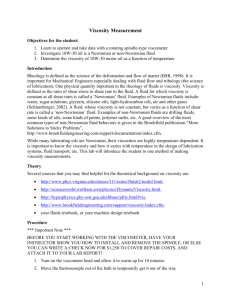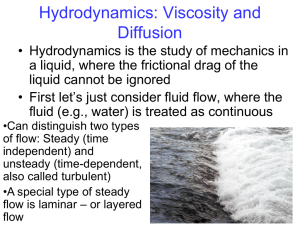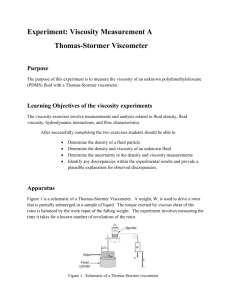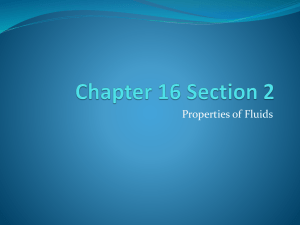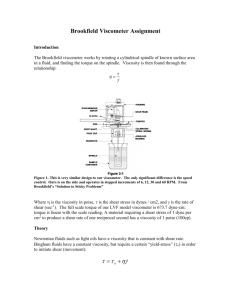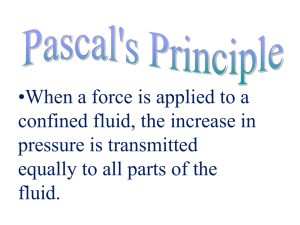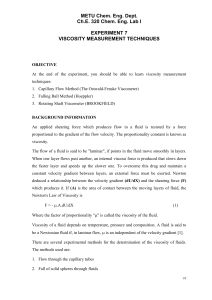Lab #1
advertisement
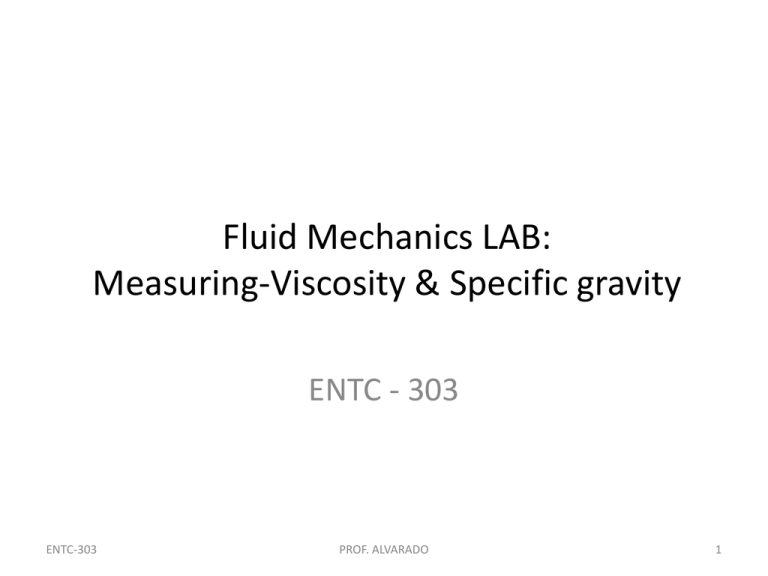
Fluid Mechanics LAB: Measuring-Viscosity & Specific gravity ENTC - 303 ENTC-303 PROF. ALVARADO 1 Objective To learn how to measure two important fluid properties: • The fluid viscosity • The fluid specific gravity Viscosity • Viscosity is a measure of the resistance of a fluid which is being deformed by either shear stress or tensile stress. • The absolute viscosity of a substance can be represented by u y • τ is the shear stress and Δu/Δy is the rate of change of the velocity with respect to the distance from the surface Reference:1. http://en.wikipedia.org/wiki/Viscosity 2. http://en.wikipedia.org/wiki/File:Laminar_shear.svg Types of Fluids • Newtonian fluids - Viscosity of the fluid is a function mainly of u the temperature of the fluid. y • Non-Newtonian fluids - Viscosity of the fluid is a function mainly of the temperature of the fluid and the velocity gradient. u n ( ) y The comparison between Newtonian and Non Newtonian Fluid u n ( ) y u y Devices • Brookfield DV-I+ digital viscometer Falling Ball Viscometer The ball inside the viscometer is made of stainless steel hydrometer – Specific gravity measuring apparatus Brookfield Viscometer Steps: 1. Turn on the viscometer switch at the back. 2. There are different kinds of spindles depending on the viscosity of fluid measured. The spindle used for this experiment is a 'zero-zero' spindle. Spindle is connected to the motor. 3. Pour the fluid in the container. 4. Insert and center spindle in the fluid until the fluid’s level is at or above the immersion groove shown in the spindle’s shaft. Make sure the spindle is set at '00'. 5. Select the desired speed setting. Set the initial speed to 1.5 RPM. If the % range is not within 10% - 99%, adjust the speed so that the % falls within the limit. 6. Use the thermometer to measure the temperature of the fluid in container. 7. Allow time for the indicated reading to stabilize. 8. Run the experiment for the same temperature at 3 different speeds1.5RPM, 3RPM and 6RPM 9. Take the average of the viscosity at the three different speeds for one single temperature. 10. wait for TA to change the temperatures on the chiller . Data • 1. Plot Viscosity vs. Temperature (at 20°C, 22°C, 24°C). • 2. Plot Viscosity vs. Rotational Velocity 1.5 RPM 3 RPM, 6 RPM (at 22°C). • Determine if the fluid is Newtonian or nonNewtonian. Falling ball Viscometer 1. Initially let the ball travel drop in the opposite direction until it crosses the red marks. 2. Invert the viscometer and note down the time taken by the ball to travel between any two red marks. 3. Take three trials of time for oil. Convert the time into minutes and take the average of the trials. Hydrometer • Make sure the Hydrometer is clean and dry. • Immerse the Hydrometer slowly in the liquid to a point below which it naturally sinks (not over 1/8"). • Do not make reading until the hydrometer and liquid are at rest and free from air bubbles. • Wait one minute until the hydrometer stabilizes. • The temperatures of the hydrometer and liquid tested should be equal. • When fluid is transparent, observe a point below the plane of the liquid surface and then raise the line of vision until this surface, seen as an ellipse, becomes a straight line. The point where this line cuts the hydrometer is the reading of the instrument. Density of fluid = SG(specific gravity) x Density of water (1 gms/ml) Temperature Speed Reading 1 Reading 2 (cP) (cP) Reading 3 (cP) Average (cP) 1.5 rpm 20 °C 3 rpm 6 rpm 1.5 rpm 22 °C 3 rpm 6 rpm 1.5 rpm 24 °C 3 rpm 6 rpm 1 (s) Falling Ball Viscometer (Viscosity) 2 (s) 3 (s) Average (s) 1 Hydrometer (Specific Gravity) 2 3 Average Average (cP)
